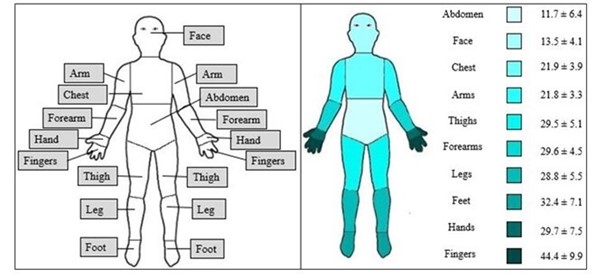Session Information
Session Type: Poster Session B
Session Time: 10:30AM-12:30PM
Background/Purpose: Skin involvement is a prominent feature of systemic sclerosis (SSc). The reliability of non-invasive tools such as high frequency skin ultrasound (HFSU) and durometry, which can respectively measure the thickness and hardness of the skin, have been assessed and further evaluation of their role in SSc is ongoing [1,2]. However, to date, few data are available in healthy subjects [3].
In this respect, body mapping of normal values of skin thickness and hardness may be a useful aid in daily practice. By employing non-invasive techniques, our pilot study provides these values in healthy individuals using HFUS and durometry in areas used to evaluate the modified Rodnan skin score (mRSS).
Methods: One-hundred-fifty-two healthy volunteers from two tertiary Rheumatology centres were enrolled (mean ages 31.2 ± 9.13, 35.5 ± 13.9 and 64.9 ±15.1 years with a percentage of females of respectively, 78%, 63% and 64% and samples sizes of 41, 48 and 63 subjects).
No systemic rheumatologic or dermatological diseases were reported for anyone. HFUS and durometry were used to assess dermal status in the different 17 mRSS areas.
The average dermal thickness was reported in mm. Hardness assessed by durometry was expressed in durometer units (DU).
Results: The upper and lower arms exhibited significantly higher durometry values and lower dermal thickness compared to the trunk regions, underscoring distinct variations across these areas (all p-values < 0.05, Fig 1 and 2).
The hardest skin was found on the finger (Fig 1), while the thickest dermal measurements were at the abdomen and thighs (Fig 2).
Dermal thickness was higher in men in multiple areas in the three cohorts, albeit with relatively modest effect sizes (r coefficients from Point biserial correlations ranging between 0.02 and 0.6).
Despite the presence of significant inter-group differences in dermal thickness, HFUS mapping showed similar topographical distributions in both centers (Fig 2).
Conclusion: The study offers the first comprehensive mapping skin status in healthy individuals obtained from two different centers.
Key findings indicate lower dermal thickness in the upper arms, legs, and feet, and higher skin hardness in peripheral areas like fingers, compared to truncal regions.
This skin mapping pilot study might provide the normal distribution values in outpatient clinics for physicians to be used when comparing the same areas in pathological conditions like systemic sclerosis-related fibrotic skin.
References: [1] Sulli et al. Arthritis Res Ther 2017, [2] Vanhaecke et al. Rheumatology 2021, [3] Santiago et al. RMD Open 2022
To cite this abstract in AMA style:
Cutolo M, Hysa E, Berghen N, Dufour T, Cere A, Wyckstandt K, Gotelli E, smith v. Mapping in Healthy Subjects Different Body Areas for Dermal Thickness and Skin Hardness by High Frequency Sonography and Durometry [abstract]. Arthritis Rheumatol. 2024; 76 (suppl 9). https://acrabstracts.org/abstract/mapping-in-healthy-subjects-different-body-areas-for-dermal-thickness-and-skin-hardness-by-high-frequency-sonography-and-durometry/. Accessed .« Back to ACR Convergence 2024
ACR Meeting Abstracts - https://acrabstracts.org/abstract/mapping-in-healthy-subjects-different-body-areas-for-dermal-thickness-and-skin-hardness-by-high-frequency-sonography-and-durometry/


